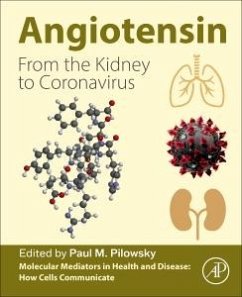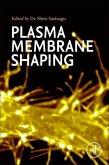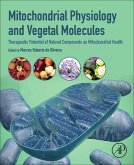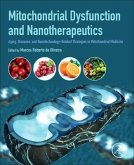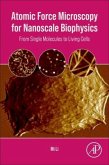Angiotensin
From the Kidney to Coronavirus
Herausgeber: Pilowsky, Paul M
Angiotensin
From the Kidney to Coronavirus
Herausgeber: Pilowsky, Paul M
- Broschiertes Buch
- Merkliste
- Auf die Merkliste
- Bewerten Bewerten
- Teilen
- Produkt teilen
- Produkterinnerung
- Produkterinnerung
Angiotensin: From the Kidney to Coronavirus, a new volume in the Molecular Mediators in Health and Disease series, presents the communication role of the hormone in both health and disease states. Beyond the most common conditions, the book also explores the role of Angiotensin in infectious diseases, like COVID-19. Sections provide background to its discovery and role in homeostasis, focus on molecular biology aspects, including genetics and measurements of its associated proteins, describe the specific actions of angiotensin in normal physiology with different organ systems, survey different…mehr
Andere Kunden interessierten sich auch für
![Plasma Membrane Shaping Plasma Membrane Shaping]() Plasma Membrane Shaping190,99 €
Plasma Membrane Shaping190,99 €![Mitochondrial Physiology and Vegetal Molecules Mitochondrial Physiology and Vegetal Molecules]() Mitochondrial Physiology and Vegetal Molecules143,99 €
Mitochondrial Physiology and Vegetal Molecules143,99 €![Revealing Uncharted Biology with Single Cell Multiplex Proteomic Technologies Revealing Uncharted Biology with Single Cell Multiplex Proteomic Technologies]() Revealing Uncharted Biology with Single Cell Multiplex Proteomic Technologies167,99 €
Revealing Uncharted Biology with Single Cell Multiplex Proteomic Technologies167,99 €![Mitochondrial Dysfunction and Nanotherapeutics Mitochondrial Dysfunction and Nanotherapeutics]() Mitochondrial Dysfunction and Nanotherapeutics167,99 €
Mitochondrial Dysfunction and Nanotherapeutics167,99 €![Atomic Force Microscopy for Nanoscale Biophysics Atomic Force Microscopy for Nanoscale Biophysics]() Mi LiAtomic Force Microscopy for Nanoscale Biophysics148,99 €
Mi LiAtomic Force Microscopy for Nanoscale Biophysics148,99 €![Mitophagy in Health and Disease Mitophagy in Health and Disease]() Mitophagy in Health and Disease167,99 €
Mitophagy in Health and Disease167,99 €![Fatty Acid-Binding Proteins and Their Roles in Human Health and Disease Fatty Acid-Binding Proteins and Their Roles in Human Health and Disease]() Asim K DuttaroyFatty Acid-Binding Proteins and Their Roles in Human Health and Disease163,99 €
Asim K DuttaroyFatty Acid-Binding Proteins and Their Roles in Human Health and Disease163,99 €-
-
-
Angiotensin: From the Kidney to Coronavirus, a new volume in the Molecular Mediators in Health and Disease series, presents the communication role of the hormone in both health and disease states. Beyond the most common conditions, the book also explores the role of Angiotensin in infectious diseases, like COVID-19. Sections provide background to its discovery and role in homeostasis, focus on molecular biology aspects, including genetics and measurements of its associated proteins, describe the specific actions of angiotensin in normal physiology with different organ systems, survey different classes of drugs that act on the Renin-angiotensin-aldosterone system, cover non-angiotensin II peptides, and more. The final part of the book is dedicated to angiotensin's role in disease states, making this the ideal reference for researchers in life sciences interested in understanding the physiological role of Angiotensin in a complete fashion. Research physicians will also benefit from the book's complete coverage of organ systems and diseases where Angiotensin plays a key role.
Hinweis: Dieser Artikel kann nur an eine deutsche Lieferadresse ausgeliefert werden.
Hinweis: Dieser Artikel kann nur an eine deutsche Lieferadresse ausgeliefert werden.
Produktdetails
- Produktdetails
- Verlag: Elsevier Science
- Seitenzahl: 832
- Erscheinungstermin: 24. Februar 2023
- Englisch
- Abmessung: 196mm x 237mm x 48mm
- Gewicht: 1700g
- ISBN-13: 9780323996181
- ISBN-10: 0323996183
- Artikelnr.: 64269316
- Herstellerkennzeichnung
- Libri GmbH
- Europaallee 1
- 36244 Bad Hersfeld
- gpsr@libri.de
- Verlag: Elsevier Science
- Seitenzahl: 832
- Erscheinungstermin: 24. Februar 2023
- Englisch
- Abmessung: 196mm x 237mm x 48mm
- Gewicht: 1700g
- ISBN-13: 9780323996181
- ISBN-10: 0323996183
- Artikelnr.: 64269316
- Herstellerkennzeichnung
- Libri GmbH
- Europaallee 1
- 36244 Bad Hersfeld
- gpsr@libri.de
Paul M Pilowsky began BMedSci(Hons), BMBS, PhD his career as a graduate student investigating, inter alia, the role of brainstem and spinal cord pathways in the control of blood pressure with a focus on serotonin. His work has now been cited more than 5000 times and published in major Journals including the Journal of Neuroscience, the Journal of Comparative Neurology and the British Journal of Pharmacology. A hallmark of his work has been the adoption of, and combination of, novel approaches to address difficult questions. He pioneered the use of combining single cell electrophysiology in vivo with immunohistochemistry. His development of isotype selective monoclonal antibodies to phosphorylated tyrosine hydroxylase enabled the detection of tyrosine hydroxylase positive presympathetic neurons in the brainstem that had become excited. He was responsible for the initial development of a new medical school at Macquarie University in Sydney. His service to Neuroscience was recognised by the award of the Australian Neuroscience Medal. He mentored 26 graduate students to on-time completion, and mentored 24 post-Doctoral Fellows, many of whom now have their own established careers. In imagining this book, it was felt that a departure from the usual highly focussed text would be of interest. Hence, a multi-Author volume has been created that reveals the multiple facets of a neurotransmitter with very broad actions.
Foreword
Paul M. Pilowsky
1. Regulation of sympathetic nerve activity by the central angiotensin
system in heart failure
Rohit Ramchandra and Julia Shanks
2. The contribution of angiotensin peptides to cardiovascular
neuroregulation in health and disease
Ewa Krystyna Szczepäska-Sadowska, Tymoteusz ¿era and Agnieszka
Cudnoch-Jedrzejewska
3. Renin Angiotensin System and inflammation
Ana Cristina Simões e Silva, Leticia Bitencourt, Juliana Lacerda de
Oliveira Campos, Bruna Luisa Fischer, Pedro Alves Soares Vaz de Castro and
Stephanie Bruna Camilo Soares de Brito
4. Targeting Renin Angiotensin System: A strategy for drug development
against neurological disorders
Bharat Bhusan Subudhi and Pratap Kumar Sahu
5. Pharmacology of Angiotensin in renovascular system
Gaaminepreet Singh, Kirti Gupta, Newly Bagang, Sandeep Arora, Onkar Bedi,
Manish Kumar and Shubham Yadav
6. The Role of Angiotensins in the Pathophysiology of Human Pregnancy
Kirsty G. Pringle, Eugenie Lumbers, Saije Morosin and Sarah Delforce
7. Hematopietic bone marrow renin-angiotensin system in health and disease
Ibrahim Celalettin Haznedaroglu and Umit Malkan
8. Angiotensin II as a mediator of renal fibrogenesis
Gunter Wolf and Ivonne Löffler
9. ANGIOTENSIN AND ATHEROSCLEROTIC VASCULAR DISEASE
Delia Salaru, Cristina Adam, Dragos Marcu, Radu Sascau and Cristian
Statescu
10. ACE2 in pulmonary diseases
Hongpeng Jia and Qing Lin
11. Renin Angiotensin Aldosterone System Inhibitors. New and Old Approaches
Carlos Maria M Ferrario, Jessica L. VonCannon, Kendra N. Wright and
Sarfaraz Ahmad
12. Aspects of the Intracellular Renin-Angiotensin System
Mark Chappell, Liliya Yamaleyeva, Hossam Shaltout and TanYa
Gwathmey-Williams
13. Drugs affecting the angiotensin system in COVID19
Fouad M. Zouein
14. ANGIOTENSIN II AND ITS ACTION WITHIN THE BRAIN DURING HYPERTENSION
Srinivas Sriramula and Vinicia Campana Biancardi
15. Morphological Aspect of the Angiotensin Converting Enzyme ACE2
Ken Yoshimura, Yasuo Okada, Shuji Toya, Shin-Ichi Iwasaki and Tomoichiro
Asami
16. Angiotensin in the eye
Dulce Elena Casarini Sr.
17. Brain renin-angiotensin system in the injured brain: The role of
astrocytes and microglia
Alberto Javier Ramos
18. Angiotensin and COVID19
Gaetano Alfano
19. Transgenic animal models for the functional analysis of ACE2
Michael Bader and Natalia Alenina
20. Role of Angiotensin in Different Malignancies
Alok Chandra Bharti, Manoj Kumar Kashyap, Anjali Bhat, Divya Janjua, Rashmi
Rao, Kulbhushan Thakur, Arun Chhokar, Nikita Aggarwal, Joni Yadav, Tanya
Tripathi, Apoorva Chaudhary and Anna Senrung
21. ACE2/Angiotensin-(1-7)/Mas Receptor Axis in the Central Nervous System:
Physiology and Pathophysiology
Aline Miranda, Antonio Lucio Teixeira, Natalia Rocha, Milene Rachid and
Eliana Toscano
22. Therapeutic Potential of Angiotensin-(1-7)
Patricia Elizabeth Gallagher, E. Ann E. Tallant and Ana Clara Melo
23. Angiotensin and Pain
Cristian Acosta, Alicia Seltzer, Sean Patterson and Susana Valdez
24. Renin-angiotensin system and emotional stress
Marco Antônio Peliky Fontes, Ana Cristina Simões e Silva and Lucas Kangussu
25. Angiotensins in obesity: focus on white adipose tissue
Eliete Dalla Corte Frantz, Dangelo Magliano, Beatriz Alexandre-Santos and
Vinícius Sepulveda-Fragoso
26. Angiotensin in the gut: role in inflammatory bowel disease
Yan Chun Li
27. The Renin-Angiotensin System in gastrointestinal functions
Maria Grazia Zizzo and Rosa Serio
28. Angiotensin in shock
Emily See, Yugeesh Lankadeva, Rinaldo Bellomo, Clive May
29. Angiotensin II and astrocytes: relevance to psychiatric disorders
Claudia Bregonzio
30. Ang II in the kidney in polycystic kidney disease
Jacqueline Kathleen Phillips, Sheran Li and Shabarni Gupta
31. The Role of Angiotensin Peptides in the Brain During Health and Disease
DAVID WONG ZHANG, T. Michael De Silva and Christopher Sobey
Paul M. Pilowsky
1. Regulation of sympathetic nerve activity by the central angiotensin
system in heart failure
Rohit Ramchandra and Julia Shanks
2. The contribution of angiotensin peptides to cardiovascular
neuroregulation in health and disease
Ewa Krystyna Szczepäska-Sadowska, Tymoteusz ¿era and Agnieszka
Cudnoch-Jedrzejewska
3. Renin Angiotensin System and inflammation
Ana Cristina Simões e Silva, Leticia Bitencourt, Juliana Lacerda de
Oliveira Campos, Bruna Luisa Fischer, Pedro Alves Soares Vaz de Castro and
Stephanie Bruna Camilo Soares de Brito
4. Targeting Renin Angiotensin System: A strategy for drug development
against neurological disorders
Bharat Bhusan Subudhi and Pratap Kumar Sahu
5. Pharmacology of Angiotensin in renovascular system
Gaaminepreet Singh, Kirti Gupta, Newly Bagang, Sandeep Arora, Onkar Bedi,
Manish Kumar and Shubham Yadav
6. The Role of Angiotensins in the Pathophysiology of Human Pregnancy
Kirsty G. Pringle, Eugenie Lumbers, Saije Morosin and Sarah Delforce
7. Hematopietic bone marrow renin-angiotensin system in health and disease
Ibrahim Celalettin Haznedaroglu and Umit Malkan
8. Angiotensin II as a mediator of renal fibrogenesis
Gunter Wolf and Ivonne Löffler
9. ANGIOTENSIN AND ATHEROSCLEROTIC VASCULAR DISEASE
Delia Salaru, Cristina Adam, Dragos Marcu, Radu Sascau and Cristian
Statescu
10. ACE2 in pulmonary diseases
Hongpeng Jia and Qing Lin
11. Renin Angiotensin Aldosterone System Inhibitors. New and Old Approaches
Carlos Maria M Ferrario, Jessica L. VonCannon, Kendra N. Wright and
Sarfaraz Ahmad
12. Aspects of the Intracellular Renin-Angiotensin System
Mark Chappell, Liliya Yamaleyeva, Hossam Shaltout and TanYa
Gwathmey-Williams
13. Drugs affecting the angiotensin system in COVID19
Fouad M. Zouein
14. ANGIOTENSIN II AND ITS ACTION WITHIN THE BRAIN DURING HYPERTENSION
Srinivas Sriramula and Vinicia Campana Biancardi
15. Morphological Aspect of the Angiotensin Converting Enzyme ACE2
Ken Yoshimura, Yasuo Okada, Shuji Toya, Shin-Ichi Iwasaki and Tomoichiro
Asami
16. Angiotensin in the eye
Dulce Elena Casarini Sr.
17. Brain renin-angiotensin system in the injured brain: The role of
astrocytes and microglia
Alberto Javier Ramos
18. Angiotensin and COVID19
Gaetano Alfano
19. Transgenic animal models for the functional analysis of ACE2
Michael Bader and Natalia Alenina
20. Role of Angiotensin in Different Malignancies
Alok Chandra Bharti, Manoj Kumar Kashyap, Anjali Bhat, Divya Janjua, Rashmi
Rao, Kulbhushan Thakur, Arun Chhokar, Nikita Aggarwal, Joni Yadav, Tanya
Tripathi, Apoorva Chaudhary and Anna Senrung
21. ACE2/Angiotensin-(1-7)/Mas Receptor Axis in the Central Nervous System:
Physiology and Pathophysiology
Aline Miranda, Antonio Lucio Teixeira, Natalia Rocha, Milene Rachid and
Eliana Toscano
22. Therapeutic Potential of Angiotensin-(1-7)
Patricia Elizabeth Gallagher, E. Ann E. Tallant and Ana Clara Melo
23. Angiotensin and Pain
Cristian Acosta, Alicia Seltzer, Sean Patterson and Susana Valdez
24. Renin-angiotensin system and emotional stress
Marco Antônio Peliky Fontes, Ana Cristina Simões e Silva and Lucas Kangussu
25. Angiotensins in obesity: focus on white adipose tissue
Eliete Dalla Corte Frantz, Dangelo Magliano, Beatriz Alexandre-Santos and
Vinícius Sepulveda-Fragoso
26. Angiotensin in the gut: role in inflammatory bowel disease
Yan Chun Li
27. The Renin-Angiotensin System in gastrointestinal functions
Maria Grazia Zizzo and Rosa Serio
28. Angiotensin in shock
Emily See, Yugeesh Lankadeva, Rinaldo Bellomo, Clive May
29. Angiotensin II and astrocytes: relevance to psychiatric disorders
Claudia Bregonzio
30. Ang II in the kidney in polycystic kidney disease
Jacqueline Kathleen Phillips, Sheran Li and Shabarni Gupta
31. The Role of Angiotensin Peptides in the Brain During Health and Disease
DAVID WONG ZHANG, T. Michael De Silva and Christopher Sobey
Foreword
Paul M. Pilowsky
1. Regulation of sympathetic nerve activity by the central angiotensin
system in heart failure
Rohit Ramchandra and Julia Shanks
2. The contribution of angiotensin peptides to cardiovascular
neuroregulation in health and disease
Ewa Krystyna Szczepäska-Sadowska, Tymoteusz ¿era and Agnieszka
Cudnoch-Jedrzejewska
3. Renin Angiotensin System and inflammation
Ana Cristina Simões e Silva, Leticia Bitencourt, Juliana Lacerda de
Oliveira Campos, Bruna Luisa Fischer, Pedro Alves Soares Vaz de Castro and
Stephanie Bruna Camilo Soares de Brito
4. Targeting Renin Angiotensin System: A strategy for drug development
against neurological disorders
Bharat Bhusan Subudhi and Pratap Kumar Sahu
5. Pharmacology of Angiotensin in renovascular system
Gaaminepreet Singh, Kirti Gupta, Newly Bagang, Sandeep Arora, Onkar Bedi,
Manish Kumar and Shubham Yadav
6. The Role of Angiotensins in the Pathophysiology of Human Pregnancy
Kirsty G. Pringle, Eugenie Lumbers, Saije Morosin and Sarah Delforce
7. Hematopietic bone marrow renin-angiotensin system in health and disease
Ibrahim Celalettin Haznedaroglu and Umit Malkan
8. Angiotensin II as a mediator of renal fibrogenesis
Gunter Wolf and Ivonne Löffler
9. ANGIOTENSIN AND ATHEROSCLEROTIC VASCULAR DISEASE
Delia Salaru, Cristina Adam, Dragos Marcu, Radu Sascau and Cristian
Statescu
10. ACE2 in pulmonary diseases
Hongpeng Jia and Qing Lin
11. Renin Angiotensin Aldosterone System Inhibitors. New and Old Approaches
Carlos Maria M Ferrario, Jessica L. VonCannon, Kendra N. Wright and
Sarfaraz Ahmad
12. Aspects of the Intracellular Renin-Angiotensin System
Mark Chappell, Liliya Yamaleyeva, Hossam Shaltout and TanYa
Gwathmey-Williams
13. Drugs affecting the angiotensin system in COVID19
Fouad M. Zouein
14. ANGIOTENSIN II AND ITS ACTION WITHIN THE BRAIN DURING HYPERTENSION
Srinivas Sriramula and Vinicia Campana Biancardi
15. Morphological Aspect of the Angiotensin Converting Enzyme ACE2
Ken Yoshimura, Yasuo Okada, Shuji Toya, Shin-Ichi Iwasaki and Tomoichiro
Asami
16. Angiotensin in the eye
Dulce Elena Casarini Sr.
17. Brain renin-angiotensin system in the injured brain: The role of
astrocytes and microglia
Alberto Javier Ramos
18. Angiotensin and COVID19
Gaetano Alfano
19. Transgenic animal models for the functional analysis of ACE2
Michael Bader and Natalia Alenina
20. Role of Angiotensin in Different Malignancies
Alok Chandra Bharti, Manoj Kumar Kashyap, Anjali Bhat, Divya Janjua, Rashmi
Rao, Kulbhushan Thakur, Arun Chhokar, Nikita Aggarwal, Joni Yadav, Tanya
Tripathi, Apoorva Chaudhary and Anna Senrung
21. ACE2/Angiotensin-(1-7)/Mas Receptor Axis in the Central Nervous System:
Physiology and Pathophysiology
Aline Miranda, Antonio Lucio Teixeira, Natalia Rocha, Milene Rachid and
Eliana Toscano
22. Therapeutic Potential of Angiotensin-(1-7)
Patricia Elizabeth Gallagher, E. Ann E. Tallant and Ana Clara Melo
23. Angiotensin and Pain
Cristian Acosta, Alicia Seltzer, Sean Patterson and Susana Valdez
24. Renin-angiotensin system and emotional stress
Marco Antônio Peliky Fontes, Ana Cristina Simões e Silva and Lucas Kangussu
25. Angiotensins in obesity: focus on white adipose tissue
Eliete Dalla Corte Frantz, Dangelo Magliano, Beatriz Alexandre-Santos and
Vinícius Sepulveda-Fragoso
26. Angiotensin in the gut: role in inflammatory bowel disease
Yan Chun Li
27. The Renin-Angiotensin System in gastrointestinal functions
Maria Grazia Zizzo and Rosa Serio
28. Angiotensin in shock
Emily See, Yugeesh Lankadeva, Rinaldo Bellomo, Clive May
29. Angiotensin II and astrocytes: relevance to psychiatric disorders
Claudia Bregonzio
30. Ang II in the kidney in polycystic kidney disease
Jacqueline Kathleen Phillips, Sheran Li and Shabarni Gupta
31. The Role of Angiotensin Peptides in the Brain During Health and Disease
DAVID WONG ZHANG, T. Michael De Silva and Christopher Sobey
Paul M. Pilowsky
1. Regulation of sympathetic nerve activity by the central angiotensin
system in heart failure
Rohit Ramchandra and Julia Shanks
2. The contribution of angiotensin peptides to cardiovascular
neuroregulation in health and disease
Ewa Krystyna Szczepäska-Sadowska, Tymoteusz ¿era and Agnieszka
Cudnoch-Jedrzejewska
3. Renin Angiotensin System and inflammation
Ana Cristina Simões e Silva, Leticia Bitencourt, Juliana Lacerda de
Oliveira Campos, Bruna Luisa Fischer, Pedro Alves Soares Vaz de Castro and
Stephanie Bruna Camilo Soares de Brito
4. Targeting Renin Angiotensin System: A strategy for drug development
against neurological disorders
Bharat Bhusan Subudhi and Pratap Kumar Sahu
5. Pharmacology of Angiotensin in renovascular system
Gaaminepreet Singh, Kirti Gupta, Newly Bagang, Sandeep Arora, Onkar Bedi,
Manish Kumar and Shubham Yadav
6. The Role of Angiotensins in the Pathophysiology of Human Pregnancy
Kirsty G. Pringle, Eugenie Lumbers, Saije Morosin and Sarah Delforce
7. Hematopietic bone marrow renin-angiotensin system in health and disease
Ibrahim Celalettin Haznedaroglu and Umit Malkan
8. Angiotensin II as a mediator of renal fibrogenesis
Gunter Wolf and Ivonne Löffler
9. ANGIOTENSIN AND ATHEROSCLEROTIC VASCULAR DISEASE
Delia Salaru, Cristina Adam, Dragos Marcu, Radu Sascau and Cristian
Statescu
10. ACE2 in pulmonary diseases
Hongpeng Jia and Qing Lin
11. Renin Angiotensin Aldosterone System Inhibitors. New and Old Approaches
Carlos Maria M Ferrario, Jessica L. VonCannon, Kendra N. Wright and
Sarfaraz Ahmad
12. Aspects of the Intracellular Renin-Angiotensin System
Mark Chappell, Liliya Yamaleyeva, Hossam Shaltout and TanYa
Gwathmey-Williams
13. Drugs affecting the angiotensin system in COVID19
Fouad M. Zouein
14. ANGIOTENSIN II AND ITS ACTION WITHIN THE BRAIN DURING HYPERTENSION
Srinivas Sriramula and Vinicia Campana Biancardi
15. Morphological Aspect of the Angiotensin Converting Enzyme ACE2
Ken Yoshimura, Yasuo Okada, Shuji Toya, Shin-Ichi Iwasaki and Tomoichiro
Asami
16. Angiotensin in the eye
Dulce Elena Casarini Sr.
17. Brain renin-angiotensin system in the injured brain: The role of
astrocytes and microglia
Alberto Javier Ramos
18. Angiotensin and COVID19
Gaetano Alfano
19. Transgenic animal models for the functional analysis of ACE2
Michael Bader and Natalia Alenina
20. Role of Angiotensin in Different Malignancies
Alok Chandra Bharti, Manoj Kumar Kashyap, Anjali Bhat, Divya Janjua, Rashmi
Rao, Kulbhushan Thakur, Arun Chhokar, Nikita Aggarwal, Joni Yadav, Tanya
Tripathi, Apoorva Chaudhary and Anna Senrung
21. ACE2/Angiotensin-(1-7)/Mas Receptor Axis in the Central Nervous System:
Physiology and Pathophysiology
Aline Miranda, Antonio Lucio Teixeira, Natalia Rocha, Milene Rachid and
Eliana Toscano
22. Therapeutic Potential of Angiotensin-(1-7)
Patricia Elizabeth Gallagher, E. Ann E. Tallant and Ana Clara Melo
23. Angiotensin and Pain
Cristian Acosta, Alicia Seltzer, Sean Patterson and Susana Valdez
24. Renin-angiotensin system and emotional stress
Marco Antônio Peliky Fontes, Ana Cristina Simões e Silva and Lucas Kangussu
25. Angiotensins in obesity: focus on white adipose tissue
Eliete Dalla Corte Frantz, Dangelo Magliano, Beatriz Alexandre-Santos and
Vinícius Sepulveda-Fragoso
26. Angiotensin in the gut: role in inflammatory bowel disease
Yan Chun Li
27. The Renin-Angiotensin System in gastrointestinal functions
Maria Grazia Zizzo and Rosa Serio
28. Angiotensin in shock
Emily See, Yugeesh Lankadeva, Rinaldo Bellomo, Clive May
29. Angiotensin II and astrocytes: relevance to psychiatric disorders
Claudia Bregonzio
30. Ang II in the kidney in polycystic kidney disease
Jacqueline Kathleen Phillips, Sheran Li and Shabarni Gupta
31. The Role of Angiotensin Peptides in the Brain During Health and Disease
DAVID WONG ZHANG, T. Michael De Silva and Christopher Sobey

